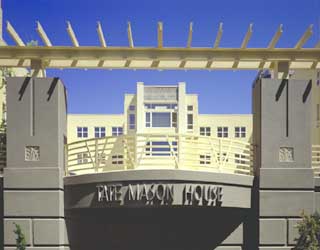
DJC.COM
June 7, 2001
Center expansion resulted in more affordable housing
Washington State Convention & Trade Center

Photo courtesy of GGLO |

|
Going well beyond its obligation to replace housing demolished to make way for the convention center in 1988, the board of directors of the Washington State Convention & Trade Center has worked as a community advocate to provide the means to create additional affordable housing units in the downtown Seattle-area.
Recognizing that the vitality of a diverse and livable city is valued by both residents and visitors, the convention center board has taken numerous actions over the years to respond to the needs of Seattle’s low-income housing residents and to provide the resources necessary to spark the development of new housing as a result of the projects implemented by the convention center.
Twelve new or rehabilitated apartment buildings with 831 long-term, low-income housing units have been created with $9.9 million in grants from the convention center funds.
The contributions have taken the form of a direct grant of cash or property without any requirement of financial return to the convention center. These funds, coupled with other government subsidies, have enabled private investors and lenders the ability to finance the reminder of construction costs.
Good examples of the effect of this program are the 44 apartments located in the historic Eagles Building renovation project. The convention center contributed the land and building together with $400,000 in cash obtained by the sale of surplus development rights from its Graham/Terry housing project.
Additional housing challenges were confronted with the recent expansion of the convention center north across Pike Street. The new construction required relocation of the residents of the aging 127-unit Waldorf Tower Apartments and its subsequent demolition. In order to make the move as smooth as possible for the Waldorf Tower residents, the convention center committed to build new replacement housing, paying $2,142 to each household for relocation costs, and contracted with Plymouth Housing Group to provide transition assistance to residents.
Seattle Housing Resources Group and Capitol Hill Housing Improvement Program were selected to build 129 units of new replacement housing on two First Hill sites. The results are the remarkable 97-unit Tate Mason House and the 32-unit Seneca Apartments. Although some residents of the Waldorf Tower initially resisted the change, the move has subsequently been very well received by the tenants.
In 1999, legislative authority to finance more low income housing units reinforced the civic mission of the convention center. While the first $9.9 million earmarked for housing was administered directly by the convention center, the state Department of Community, Trade, and Economic Development (CTED) received an additional $5 million. CTED identifies and administers the funds for low income housing programs.
The economic impact of the convention center has extended well beyond the creation of jobs and income for the citizens of Washington. Its directors have consciously aimed a portion of the profits received from convention guests to provide civic benefits for the community. Over the years, this money has also contributed to parks, walkways, plazas, historic preservation, support for the arts and public safety improvements. This is particularly noteworthy because none of these community enhancements were paid for by local taxpayers, but rather by the taxes paid by out-of-town visitors.
Linda Willanger serves as director, executive service for the Washington State Convention & Trade Center. She was a member of the staff for the grand opening of the Convention Center in 1988, and currently directs human resources, WSCTC University, community relations and other staff services.
Other Stories:
- Expanding for the future
- Hey, big spender! You’re wanted in Seattle
- Thinking outside the box
- A bridge to controversy
- Convention center showcases public art
- Un-conventional sites add complexity to convention center design
- From concept to reality
- Dance of the developers
- A 'shimmering' canopy belies some steely calculation
Copyright ©2009 Seattle Daily Journal and DJC.COM.
Comments? Questions? Contact us.